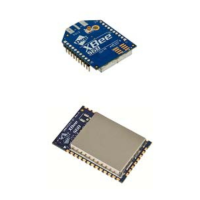© 2014 Digi International Inc. 52
XBee/XBee-PRO
®
DigiMesh 2.4 User Manual
Changing the Sleep Parameters
Any sleep compatible node in the network which does not have the non-sleep coordinator sleep
option set can be used to make changes to the network’s sleep and wake times. If a node’s SP
and/or ST are changed to values different from those that the network is using, the node
becomes the sleep coordinator. That node begins sending sync messages with the new sleep
parameters at the beginning of the next wake cycle.
Note: For normal operations, a module will use the sleep and wake parameters it gets from
the sleep sync message, not the ones specified in its SP and ST parameters. The SP and ST
parameters are not updated with the values of the sync message. The current network sleep
and wake times used by the node can be queried using the OS and OW commands.
Note: Changing network parameters can cause a node to become a sleep coordinator and
change the sleep settings of the network. The following commands can cause this to occur:
NH, NN, and MR. For most applications, we recommend configuring the NH, NN, and MR
network parameters during initial deployment only. The default values of NH and NN are
optimized to work for most deployments. In most applications, these network parameters
should only be configured during deployment.
Sleep Guard Times
To compensate for variations in the timekeeping hardware of the various modules in a sleeping
router network, sleep guard times are allocated at the beginning and end of the wake time. The
size of the sleep guard time varies based on the sleep and wake times selected and the number
of cycles that have elapsed since the last sync message was received. The sleep guard time
guarantees that a destination radio will be awake when a transmission is sent. As more and more
consecutive sync messages are missed, the sleep guard time increases in duration and decreases
the available transmission time.
Auto-Early Wake-Up Sleep Option
Similarly to the sleep guard time, the auto early wake-up option decreases the sleep period
based on the number of sync messages missed. This option comes at the expense of battery life.
Auto-early wake-up sleep can be disabled using the sleep options (SO) command.
XBee DigiMesh Configuration
Selecting Sleep Parameters
Choosing proper sleep parameters is vital to creating a robust sleep-enabled network with a
desirable battery life. To select sleep parameters that will be good for most applications, follow
these steps:
1 Choose NN and NH: Based on the placement of the nodes in your network, select
appropriate values for the Network Hops (NH) and Network Delay Slots (NN) parameters.
Note: The default values of NH and NN have been optimized to work for the majority of
deployments. In most cases, we suggest that these parameters not be modified from their
default values. Decreasing these parameters for small networks can improve battery life, but

